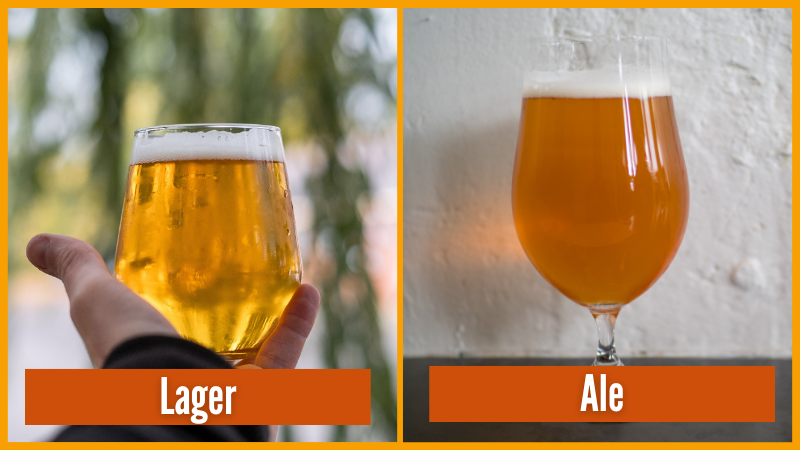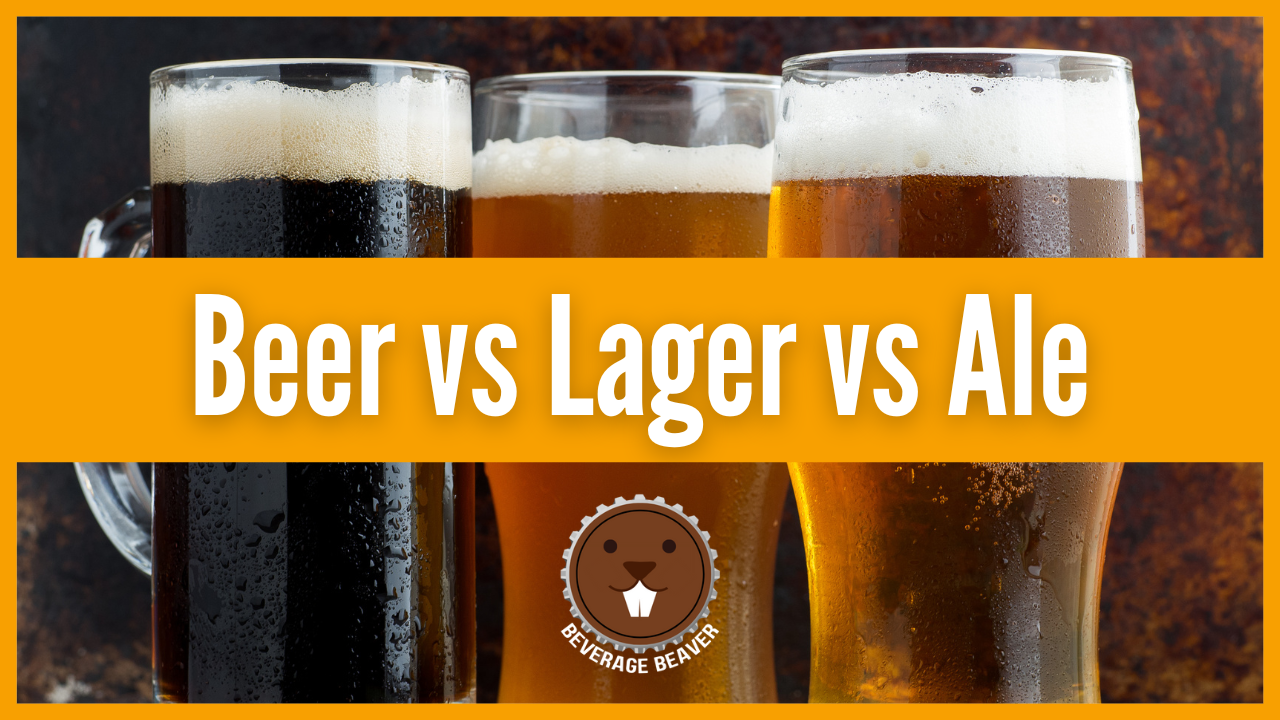Beer vs Lager vs Ale | An Easy Guide To Understanding The Difference
If you’re a casual beer drinker, understanding the difference between beer, lager, and ale might not seem all that important. However, gaining this knowledge can significantly enrich your drinking experience by helping you identify your favorite types of beer while also enhancing your appreciation for the craftsmanship that it takes to make the perfect brew. So, what is the difference between beer, lager, and ale?
Beer is the overarching category of fermented beverages made from water, malt, hops, and yeast. Ale and lager are both subtypes of beer, distinguished primarily by the yeast used and the fermentation conditions. Ales use top-fermenting yeast and ferment at warmer temperatures, resulting in complex and fruity flavors. Lagers, on the other hand, use bottom-fermenting yeast and ferment at cooler temperatures, leading to cleaner, crisper tastes.
Obviously, there is a lot more to explore when it comes to lager vs ale. In this guide, we will explain in detail the key differences between lager and ale, from their historical origins and unique ingredients to their diverse flavor profiles and ideal food pairings. First, let’s get started with some definitions.
Beer vs Lager vs Ale: Definitions
Beer
Beer is a fermented beverage made from four basic ingredients: water, malted barley (or other grains), hops, and yeast. The fermentation process involves the yeast consuming sugars from the malt and converting them into alcohol and carbon dioxide, resulting in a drink that can vary greatly in flavor, color, and alcohol content.
Ale
Ale is a type of beer characterized by its use of top-fermenting yeast, which ferments at warmer temperatures (usually between 60-75°F or 15-24°C). This leads to a quicker fermentation process and often results in a beer with a more complex, fruity, and robust flavor profile.
Lager
Lager is another type of beer that utilizes bottom-fermenting yeast, which ferments at cooler temperatures (usually between 45-55°F or 7-13°C). The lower fermentation temperature and longer fermentation period result in a beer that is typically cleaner, crisper, and smoother than its ale counterpart.
Lager vs Ale: History And Origins
Origins of Ale
Ale is one of the oldest types of beer and has its roots in ancient times. It was brewed in various forms by early civilizations like the Egyptians and Mesopotamians and has been a staple in European cultures for millennia. Because ale fermentation requires warmer temperatures, it was easily brewed in diverse climates, making it a widespread choice for early brewers.
Origins of Lager
Lager is a relatively newer development in the world of beer, tracing its origins to Central Europe in the late Middle Ages. Its unique fermentation process, requiring cooler temperatures, likely originated in the Bavarian region where brewers stored their beer in cool mountain caves during the warmer months. This naturally led to the cleaner, crisper beer we know as lager today.
Lager vs Ale: Ingredients
In general, both lagers and ales are made from four basic ingredients: water, malted barley (or other grains), hops, and yeast. These ingredients combine through the brewing process to create a wide variety of beers. However, the ingredients used in lagers and ales can vary slightly to create distinct flavor profiles.
Ales often use specific types of malt and hops that lend themselves to a fuller, fruitier flavor profile. For example, caramel or chocolate malts can be used in ales to add sweetness and color. Specialty grains like wheat or rye may also be used to add unique characteristics to different ale varieties, such as a smoother mouthfeel or spicier notes. Ales use top-fermenting yeast, which ferments at higher temperatures and tends to produce more complex, fruity flavors as a result.
Lagers, on the other hand, frequently utilize lighter malts and fewer hop varieties, aiming for a cleaner, simpler taste. For example, Pilsner malt is often used in lagers to achieve a pale, golden color and a crisp flavor. Lagers use bottom-fermenting yeast, which ferments at cooler temperatures. This results in fewer fruity esters and a more subdued, cleaner profile that allows the malt and hops to shine through.
Lager vs Ale: Brewing Process
The brewing process for lagers involves a technique known as “lagering,” where the beer is conditioned at low temperatures for several weeks or even months. This occurs after the initial fermentation and is done to allow the flavors to mellow and meld together, resulting in a cleaner, more refined taste. The yeast used for lagers is bottom-fermenting, which means it settles at the bottom of the fermentation vessel and works more slowly, especially at the cooler temperatures preferred for lager production.
In contrast, the brewing process for ales is generally faster due to the use of top-fermenting yeast that operates at warmer temperatures. After the initial fermentation, ales typically don’t require the extended conditioning time that lagers do. This leads to a quicker turnaround and allows for a broader range of flavors and aromas to develop, influenced by the yeast, malt, and hops used.
The primary differences between the brewing processes for lagers and ales lie in the type of yeast used and the temperature and duration of fermentation. Lagers use bottom-fermenting yeast and undergo a longer, cooler fermentation and conditioning period, which contributes to their cleaner, crisper profile. Ales, on the other hand, use top-fermenting yeast and ferment at warmer temperatures for a shorter period, allowing for a greater diversity of flavors and aromas to emerge.
Lager vs Ale: Alcohol Content
The alcohol content in both lagers and ales can vary widely depending on the specific style and brewing process, but there are some general trends. Lagers often have a lower alcohol by volume (ABV), usually ranging from about 4% to 5.5%. This is because the cooler fermentation temperatures and longer conditioning times typically used in lager production tend to result in a less alcoholic brew.
Ales, however, often have a higher ABV, ranging from around 5% to even 12% or more for certain styles like Belgian ales or Imperial stouts. The warmer fermentation temperatures and shorter fermentation times in ale production often lead to a brew with more alcohol.
Lager vs Ale: Flavor and Appearance
When it comes to flavor, lagers and ales offer distinctly different profiles. Lagers usually present a cleaner, crisper taste with a focus on the simplicity and quality of the malt and hops. The cooler fermentation temperatures and longer conditioning times contribute to this refined profile, which often lacks the fruity esters or complex flavors commonly found in ales. In terms of appearance, lagers are generally clearer and can range from very pale to amber, although there are darker variations like Dunkels and Schwarzbiers.

Ales, by contrast, offer a much broader spectrum of flavors and aromas, thanks to the top-fermenting yeast and warmer fermentation temperatures. Ales can be fruity, spicy, malty, or hoppy, depending on the specific type of malt, hops, and yeast used. Appearance-wise, ales can also vary widely, from pale gold to dark brown or even black for styles like stouts and porters. The broader range of flavors and appearances in ales is often what attracts craft beer enthusiasts looking for more complexity.
Lager vs Ale: Examples
Lager Examples
When it comes to lagers, some iconic brands come from various parts of the world, including the United States and Europe. Here are a few examples:
- Stella Artois: This Belgian lager is known for its balanced malt and hop profile, crisp finish, and golden color.
- Budweiser: An American take on the lager style, it’s known for its light flavor and wide availability.
- Heineken: This Dutch lager is another globally recognized brand, offering a slightly bitter but smooth taste.
- Yuengling Traditional Lager: America’s oldest brewery offers this flagship lager with a distinctive amber color and balanced flavor.
- Corona: This Mexican lager is famous for its light, refreshing taste and is often enjoyed with a slice of lime.
Ale Examples
Ale covers a vast range of styles and flavors, making it a versatile choice. Some well-known examples include:
- Blue Moon Belgian White: This is an American interpretation of a Belgian Witbier, featuring orange peel and coriander spices.
- Guinness: An Irish Stout, a subtype of ale, that’s known for its dark, creamy richness.
- Spotted Cow: Brewed by New Glarus Brewing Company in Wisconsin, this is a Farmhouse Ale known for its fruity flavors and cloudy appearance.
- Dogfish Head 90 Minute IPA: An American India Pale Ale, characterized by its high hop bitterness and higher alcohol content.
- Newcastle Brown Ale: A British brown ale that’s malt-forward with notes of caramel and toffee.
Lager vs Ale: Food Pairings
Lagers, with their cleaner and crisper profiles, pair exceptionally well with lighter foods that won’t overpower their subtler flavors. Think seafood, grilled chicken, or even salads. The refreshing qualities of a lager can also act as a palate cleanser, making it a good match for spicier dishes like tacos or Thai food. Additionally, lighter lagers can complement salty snacks like pretzels or chips, while darker lagers can stand up to richer dishes like sausages or stews.
Ales, on the other hand, offer a broader range of flavors that can be paired with a diverse array of foods. The fruity and spicy notes in many ales can complement dishes that have a similar flavor profile, such as a fruity chutney or spicy barbecue. Richer, darker ales like stouts and porters are often recommended with hearty meals like steaks or even desserts like chocolate cake. Hop-forward ales like IPAs can cut through the richness of fatty foods like burgers or pizza, while the more nuanced flavors in Belgian ales can elevate a fine dining experience.
Learn the key principles and guidelines for matching beers with food with our complete guide to beer-food pairing.
Wrapping Up
If you’ve made it this far, congratulations. You should now have a better understanding of the key differences between beer, lager, and ale. Understanding these differences is not just about semantics or beer snobbery. It’s about enhancing your overall experience and appreciation for one of the world’s most beloved beverages.
Lager vs Ale: FAQ
Is Lager Stronger Than Ale?
In terms of alcohol by volume (ABV), ales generally tend to be stronger than lagers. While there are exceptions, ales usually have an ABV ranging from 5% to 12% or more, depending on the style. Lagers often have a lower ABV, usually between 4% and 5.5%.
Does Lager or Ale Have More Calories?
Caloric content in beer is primarily related to its alcohol content and the amount of residual sugars. Generally speaking, higher ABV beers will contain more calories. Since ales often have a higher ABV than lagers, they can be more caloric. However, this can vary significantly based on the specific style and brewing process.
What’s the Difference Between Lager and Pilsner?
A Pilsner is actually a type of lager, originating from the city of Plzeň in the Czech Republic. Pilsners are known for their pale, golden color and crisp, refreshing taste. They are usually more hoppy than other types of lagers. So while all Pilsners are lagers, not all lagers are Pilsners.
Is Ale Carbonated?
Yes, ales are generally carbonated, much like lagers. The level of carbonation can vary depending on the specific style and brewing process, but ales usually have a level of carbonation that complements their flavor profile.
Is IPA an Ale?
Yes, IPA (India Pale Ale) is a type of ale. It is characterized by a higher hop bitterness and often a higher alcohol content compared to other ales. IPAs can vary widely in flavor, but they are generally robust and complex with floral, fruity, or piney notes.
Can I Age Lager or Ale?
Both lagers and ales can be aged, but they age differently and not all styles are suitable for aging. Strong ales, like barleywines or Belgian strong ales, are often considered good candidates for aging due to their higher alcohol content and complexity. Most lagers are best enjoyed fresh, but some stronger or darker styles can also benefit from aging.
Which is More Popular, Lager or Ale?
Lagers, particularly lighter styles like Pilsners and American light lagers, tend to be more widely consumed globally. However, the craft beer movement has led to a resurgence in popularity for various ale styles, from IPAs to stouts and sours.
What’s the Best Serving Temperature for Lager and Ale?
Lagers are usually best served at colder temperatures, between 38–45°F (3–7°C), while ales often reveal their full range of flavors when served a bit warmer, usually between 45–55°F (7–13°C). Serving temperature can significantly impact your enjoyment of the beer, so it’s worth paying attention to.

